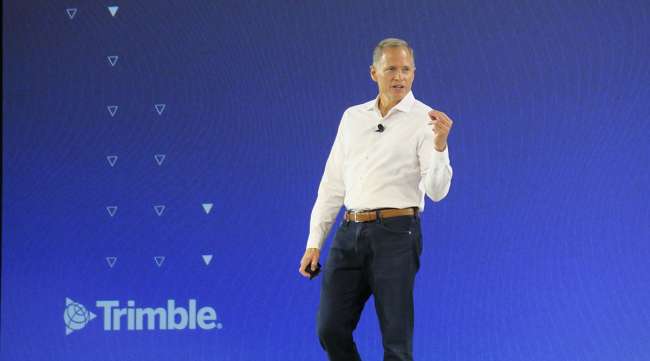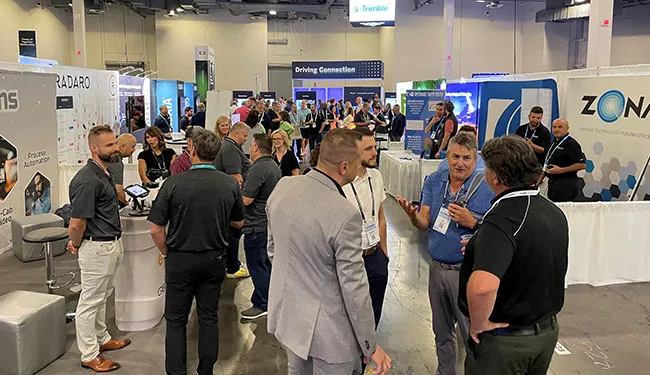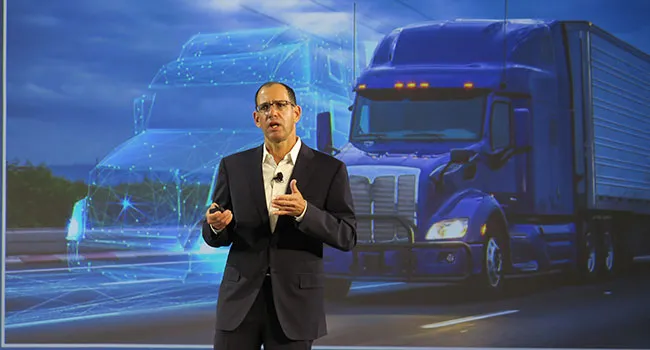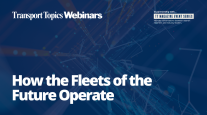Managing Editor, Features and Multimedia
Trimble Continues Quest to Improve Connectivity in Trucking

[Stay on top of transportation news: Get TTNews in your inbox.]
LAS VEGAS — As Trimble expands its transportation technology division through new product development and yet another major acquisition, the company is seeking to streamline industry workflows and forge closer connections among drivers, trucks, carriers, shippers and logistics providers.
“Our vision at Trimble is to deliver products and services that connect the digital and physical worlds,” CEO Rob Painter said at the company’s 2023 Insight Tech Conference & Expo, held Sept. 24-27. “In transportation, our vision is to create a global, seamless, connected supply chain.”
To advance that mission, Trimble is working to connect disparate data streams through a common, cloud-based ecosystem.
That starts with better connecting Trimble’s broad technology portfolio, which includes transportation management software, fleet telematics, mapping and routing, freight visibility, onboard video and more. Beyond its own technology offerings, Trimble also is integrating products and services provided by its traditional competitors inside this data ecosystem.
“When we drive connection, success looks like helping you become better, faster, safer, cheaper, greener,” Painter said. “It’s about making a positive impact on your business.”
This technology conversion can help transportation companies optimize planning for specific arrival times, guide drivers to the right entry points, minimize wasted time at facilities, boost asset utilization and improve the driver experience, he added.

Attendees check out vendor exhibits at Trimble Transportation’s Insight Tech Conference and Expo in Las Vegas. (Seth Clevenger/Transport Topics)
Trimble has been expanding the reach and capabilities of its technology through a mix of in-house development work and acquisition.
Since 2020, Trimble has invested more than $2 billion in research and development, Painter said.
“We’re not just talking about innovation, we’re investing in it,” he said.
In April, Trimble completed its purchase of Germany-based software company Transporeon for 1.88 billion euros, marking the largest acquisition in Trimble’s 45-year history.

Gragg Wilson of UPS won grand champion honors at the National Truck Driving Championships. Wilson takes us through the competition's course, successful driving practices and how to attract new drivers. Tune in above or by going to RoadSigns.ttnews.com.
Painter described Transporeon as the largest transportation management platform in the world. Globally, that business manages more than 50 billion euros in freight on an annual basis, connects with more than 1,400 shippers and 150,000 carriers, and has formed more than 3,000 integrations with enterprise resource planning systems, transportation management systems and warehouse management systems.
The Transporeon business complements Trimble’s existing transportation technology division, Painter said. While Trimble Transportation has traditionally been carrier-centric and focused primarily in North America, Transporeon has focused more on the shipper and logistics side of the industry with a heavy concentration in Europe.
At the same time, Trimble has been investing in around-the-clock cybersecurity protection for an industry that has become a prime target for ransomware and other cyberattacks in recent years.
Transportation was the sixth most targeted industry by cybercriminals in 2022, Painter said. “You might think you’re a trucking company. Increasingly, you’re a data company.”

Trimble’s Ron Bisio discusses how the company is connecting its various technology products through the Trimble Transportation Cloud. (Seth Clevenger/Transport Topics)
Ron Bisio, senior vice president of Trimble’s Transportation division, provided an update on the rollout of the Trimble Transportation Cloud platform.
Trimble has been ramping up that cloud-based IT ecosystem through a partnership with Microsoft and its Azure cloud computing business.
“Since announcing it last year, we now have multiple workflows being used consumed by real-live customers,” Bisio said. “Customers are using Trimble Transportation Cloud today to help bid on freight with greater accuracy, to help manage their active repair orders more efficiently, [and] to help customers’ data move from TMS to telematics to driver workflows seamlessly and instantaneously.”
Dart Transit Co., for example, has been on a mission to better connect the back office and the cab for improved safety, efficiency and regulatory compliance, Bisio said. To achieve those objectives, the Eagan, Minn.-based carrier has deployed Instinct, Trimble’s next-generation in-cab telematics system built on top of the Trimble Transportation Cloud, he said.
Dart Transit ranks No. 89 on the Transport Topics Top 100 list of the largest for-hire carriers in North America.
Bisio also highlighted Tri-National Inc., a carrier based in St. Charles, Mo., that was seeking opportunities to find additional freight. The company is using Trimble’s Engage Lane, a dynamic freight procurement system, to more easily onboard new shippers without the need for multiple integrations, he said.
Want more news? Listen to today's daily briefing above or go here for more info
Finally, Bisio cited Crete Carrier Corp.’s move to a more unified driver workflow where data flows seamlessly between the Lincoln, Neb.-based carrier’s telematics and transportation management systems. This driver workflow provides the back office with complete and uniform data visibility, he said.
Crete ranks No. 38 on the for-hire TT 100.
Bisio also announced the addition of “hyperlocal” weather alerts for Trimble’s CoPilot commercial navigation product.
“Your drivers are going to get timely notifications when there’s disruptive or extreme weather that’s going to be on their route,” he said. “In the past, they would wonder if weather is going to impact their trip. Now they are going to know with certainty.”
These types of technology deployments have been enabled by the growth of connectivity, computing power and cloud IT infrastructure. Painter reflected on the accelerating pace of change driven by those trends.
“Think about the compute power it took to put men on the moon in the ’60s. That’s sitting in your hands now on your phone,” he said.
Painter also cited the expansion of artificial intelligence and programs such as the AI chatbot tool ChatGPT.
“What’s happening in artificial intelligence and generative AI is astonishing,” Painter said. “It has the potential to add trillions of dollars of impact to our economy. It has the impact to change the anatomy of how we work.”




